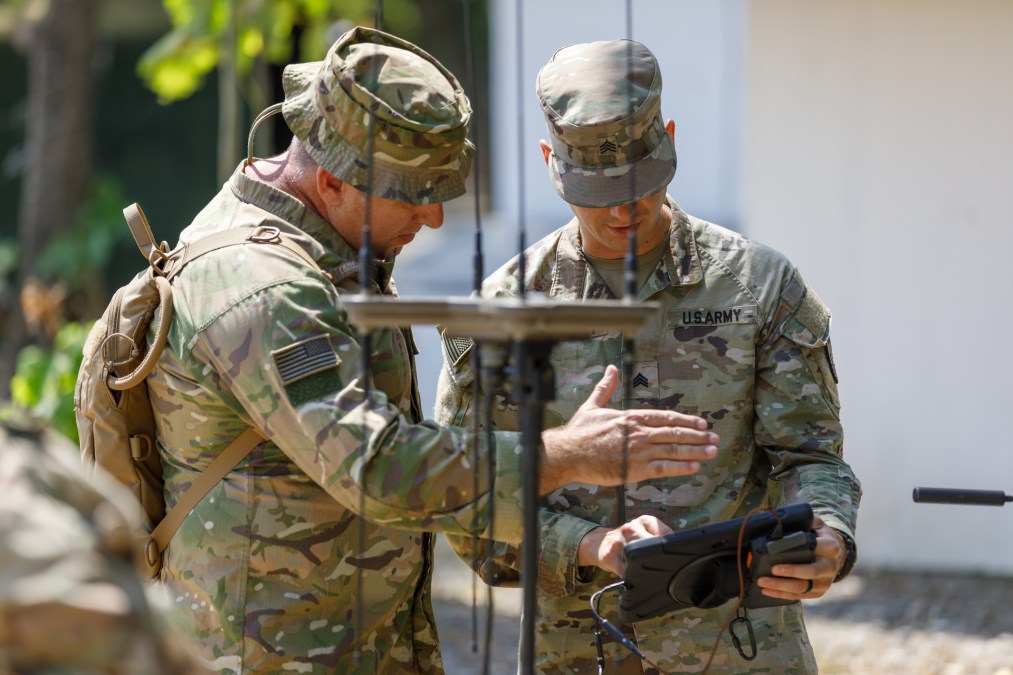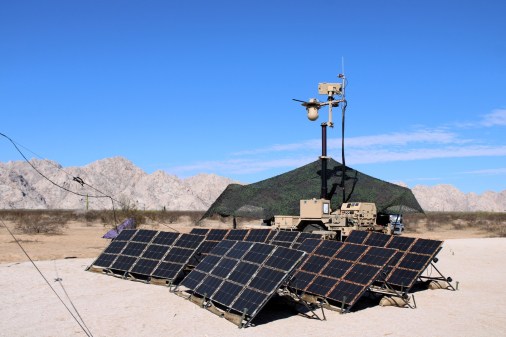One electronic warfare payload to rule them all?

AUGUSTA, Ga. — The Army is designing a new universal electronic warfare capability to enable rapid updates to equipment on any platform.
The Modular Mission Payload is a concept for a standardized kit that can be integrated into platforms and allow almost any EW capability to be loaded on.
While the Army has sought in the past to go in the direction of open standards and architectures to allow for quick updates to capabilities in the face of dynamic threats, part of the need for a new universal enabling capability is the service’s divestment of several systems.
Under the continuous transformation effort, first announced in April, the service is getting rid of Humvees and Joint Light Tactical Vehicles and will stop purchasing Gray Eagle drones, among other cuts.
Given the Army doesn’t know what platforms will replace those systems in the future, the electronic warfare enterprise is seeking to develop agnostic electronic warfare systems that can integrate with whatever the Army eventually chooses.
“We’re clear that we’re transforming, but we’re not always clear where we’re heading. But for good reason too. I think there’s a lot of value in that,” said Col. Scott Shaffer, project manager for EW and cyber within program executive office for intelligence, electronic warfare and sensors. “It encourages a little more innovation and creativity, not just build specifically to a Humvee or something like that.”
In a perfect world, the payload would resemble the Picatinny rail system, officials said, where it could have the same chassis and whatever radio or amplifier is needed for the mission can be integrated.
The Army is starting small with the payload for now. If it needs to grow, the technology can provide more range and capability on future platforms.
One reason for that approach is the desire to get EW capability onto smaller drones. The other factor is other open architecture systems might be too big for those smaller platforms.
The modular concept differs some from the idea of the C5ISR/EW Modular Open Suite of Standards (CMOSS) architecture in which officials envision being able to swap in and out software-based cards to rapidly adapt to threats. Those cards can be for several different capabilities such as software-defined radios and other equipment, which can fill up quickly.
“CMOSS has been that primary chassis and [size, weight and power] consideration, [but] we recognize that CMOSS may be too heavy for your lighter weight UAS. It may be too cumbersome, or the power requirements on that AFV may be too may be too cumbersome for that CMOSS chassis to be able to integrate,” Col. Leslie Gorman, Army capability manager for electromagnetic warfare, said at the TechNet Augusta conference on Wednesday. “With the modular EW systems, we’re looking at lighter weight chassis, in some cases, dual-use EW sensors, you can do a lot with SDRs, and then what can we modify on software on some of these sensors and effectors on the battlefield to get that modularity that can be integrated in multiple fighting platforms.”
Now that the Army has moved on from Gray Eagle, which had been the primary platform for the service’s aerial EW effort — MFEW — officials are looking at how to put sensors and effectors on Group 1 and Group 2 drones, which are much smaller, or even on autonomous fighting vehicles at the forward line of troops. The Army has decided to transition MFEW in favor of an incremental approach to deliver capability that will evolve over time toward the full Army’s airborne electromagnetic attack requirements, according to a spokesperson. It will now prioritize commercial-off-the-shelf and government-off-the-shelf solutions to rapidly deliver capabilities for testing and feedback with TiC units in early fiscal 2026, they added.
With a standard electronic warfare configuration, everything can be enclosed in one payload.
The modular concept is still in the prototyping phase, but adheres to the Army’s larger push toward leveraging commercial-off-the-shelf gear.
“The Army has taken a, probably a pretty good pivot, going from like ground-up EW capability development to more COTS based,” Shaffer said. “With the pivot, that gives us more options to experiment going forward and look at those different platforms: air, ground, but all EW focused.”
Now, with a standard kit, as long as vendors adhere to the architecture, they can insert their capabilities without issue.
Moreover, the Army is moving away from dedicated electronic warfare vehicles that will conduct jamming or sensing. The service made the decision not to go forward with the Terrestrial Layer System-Brigade Combat Team, which was originally envisioned as a vehicle-mounted integrated signals intelligence and electronic attack system that officials planned to put on Strykers.
Instead, the Army will be using a Modular Adapter Kit to mount the Manpack to vehicles.
Additionally, with the modular payload approach, almost anything can become an EW system.
“We’re past that point of where you’re going to have a dedicated EW vehicle trying to move across a battlefield, antennas looking like a porcupine. We’re really trying to get to a more mission modular payload, because we recognize that electromagnetic warfare is a critical enabler across all warfighting functions,” Gorman told the conference.
While the Army walked away from the brigade version of TLS, it is still looking at its larger cousin, the Echelons Above Brigade family of systems, meant for the division level for longer-range electronic warfare.
The Army wants a SIGINT version, electronic warfare version and extended-range version, but it’s now looking at making that platform more modular than initially envisioned.
“We’re looking for it to be a more modular capability, so that way it can be moved from vehicle to vehicle,” Gorman told conference attendees.
Shaffer said in an interview that the Army wants more time to prototype the EAB family to get it right.
“We just need a little more time to clarify the capabilities out there, take … a little more of a commercial COTS approach to how we’re putting kit together, and then making sure the requirements are really where they need to be. We’re still in lesson learned and prototyping,” he said. “We’ve got to get it right. I feel like the Army has the brigade and below solution. The division and above, we need to get it right … We’re at a point we’re still really got to narrow it down.”
Next year, the Army will be prototyping the effort in the hopes of getting it into an exercise, possibly at Project Convergence Capstone 6.
Updated on Aug. 22, 2025, at 10:30 AM: A previous version of this story inaccurately stated that the Army’s MFEW effort had been canceled. This story has been updated to include information provided by an Army spokesperson about transition plans for MFEW.






